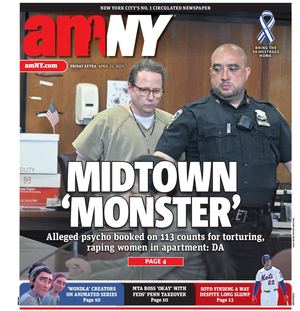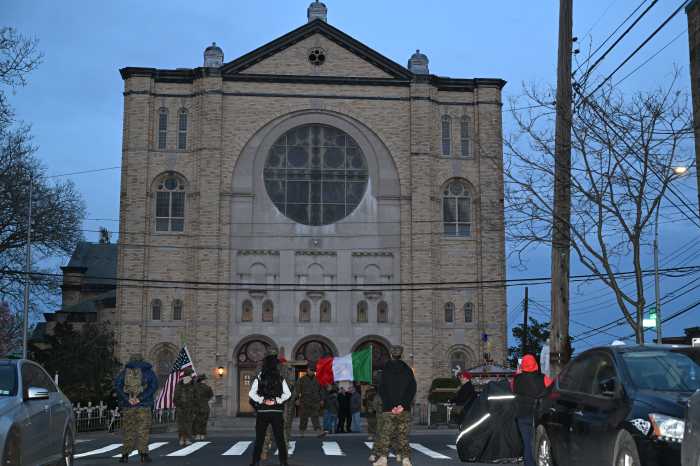BY Aline Reynolds
Some Downtown youngsters may soon have lengthy bus rides to get to school each day if the city goes ahead with its plan to rezone the area south of 14th St.
The School Construction Authority, a branch of the NYC Department of Education, announced last week that it would be funding new school seats based on newly designated sub-districts, rather than districts, for the first time. This system would divide Lower Manhattan into east and west at Broadway. To the community’s angst, the new plan groups “Lower Manhattan West” and Tribeca with the Village; and “Lower Manhattan East” with Chinatown.
The Department’s new and existing resources for the two Downtown subdistricts are projected to be sufficient for the area’s seat capacity needs, according to the DOE’s latest projections. Liz Bergin, the department’s vice president of capital plan management, presented the data to NYS Assembly Speaker Sheldon Silver’s School Overcrowding Task Force on Thurs., April 14.
The April amendment to the 2010-14 Capital Plan funds 1,301 new seats for Tribeca, the Village and Lower Manhattan West — greater than the 725 additional seats needed in these neighborhoods by 2014, according to the DOE. The SCA overprotected the capacity needs of District Two, Bergin explained, because the area’s housing sector is not growing as quickly as previously anticipated. (The Department did not immediately identify where they would secure the additional 225 needed seats in Chinatown and Lower Manhattan East.)
Bergin assured that there are enough seats for Downtown youngsters in the pipeline — 518 seats, for example, at the Foundling Hospital (P.S. 340), which is slated to open in 2014; 476 seats in a new Downtown elementary school tentatively sited at One Peck Slip; and 307 seats in I.S. 868.
“We recognize the need for seats [and] we’re trying to get them here as quickly as we possibly can,” Bergin told the task force.
The data compiled by Community Board 1, “has validity just as ours has validity,” Bergin said. But while CB 1’s analysis looks at the total number of births in the board’s district, the DOE’s analysis is based on total number of births by ethnicity group within various districts, she noted. And, unlike CB1’s projections, which sets boundaries by the community board’s district, CB 1 overlaps the new subdistricts in the Department’s analysis.
Task force members, however, find the DOE’s rezoning plan to be illogical, and considers its enrollment projections unfounded.
Eric Greenleaf, a professor at the New York University Stern School who has come up with his own overcrowding data for Downtown, objects to the way that the DOE is splitting Lower Manhattan down the middle. “It makes no sense at all,” he said, “especially given what’s happened Downtown in the last 10 years.”
“9/11, if nothing else, drove the point home to our parents that they want their kids close to home,” echoed Paul Hovitz, co-chair of CB 1’s youth and education committee. “To have youngsters sitting on a school bus in traffic, and spending what could be learning time in a school, is unacceptable.”
The Village, Hovitz noted, “is not in our neighborhood – it’s not even in our community board.”
Elizabeth Rose, director of portfolio planning at the DOE, pointed out that the Department doesn’t consider community board districts to be the boundary lines that separate school zones.
Shino Tanikawa, a member of District Two’s Community Education Council, deemed the Department’s rezoning proposal “bogus.”
“There is no room north of Canal St. — P.S. 3 is full, and P.S. 41 has a wait list,” she said. “What they’re trying to do is fix overcrowding by rezoning, but rezoning does not create seats.”
The task force was equally opposed to the DOE’s enrollment numbers. The Department, Greenleaf said, is contradicting itself by claiming to have enough space for Downtown students when, at the same time, it is putting twice as many school children into Spruce St. next fall, for example, than it has capacity for.
“You’ve underprojected, not overprojected… I’m not clear where you see all this space,” echoed Leonie Haimson, executive director of Class Size Matters, who found Bergin’s presentation difficult to understand.
Task force members are particularly concerned that the fate of Spruce St.’s middle school might be doomed due to a forthcoming seat shortage. The Beekman Tower, Spruce’s permanent home, Task force member Tricia Joyce noted, only has eighteen available classrooms.
“With four classes per grade, by the time [the students] are in fourth grade, they will have filled the entire school meant as a K-to-8,” said Joyce. “Clearly, you can see you’re borrowing rooms from your school, and the day will come when you fill the school well before that school was meant to be filled. This is not a logical approach to planning.”
Hovitz also had qualms with the DOE’s ethnicity-based approach toward its enrollment projections. “The fact that they listed [ethnicity] as the key source as to how they project what groups stay and go, was very, very disconcerting to me,” he said, claiming the method to be “borderline bigoted.”
During the task force meeting, Rose boasted Downtown’s slim waitlists, which she said are substantially lower this spring — at 34 students — than around the same time last spring — at 62 students.
The smaller waitlists, the task force members countered, is misleading, since some of the Downtown schools added extra sections just to be able to take in additional students next fall. P.S. 276 and P.S. 89, for instance, will both have four kindergarten sections, with capacity for only three.
“It puts pressure on our principals to keep accommodating all these extra kids just because they have extra elementary classrooms right now,” said Joyce. “That’s not a good strategy, and it’s going to be disastrous for our schools.”
The task force also discussed the possibility of expanding the Peck Slip school to fit more than the Department’s currently planned count of 476 students. “If you have space that has a greater capacity,” Silver suggested, “rather than to have to find another space that takes us years, I’d suggest we build out to the maximum that we can.”
The Department, Rose assured, would occupy the entirety of the Peck Slip space that the DOE will acquire, which could possibly translate into more seats. The SCA, she said, is proceeding with exclusive negotiations with the U.S. Postal Service to finalize the acquisition of the space.
The school is still scheduled to open in Fall 2015.
In other news, Silver praised Mayor Bloomberg’s choice to replace NYC Schools Chancellor Cathie Black with Dennis Walcott, the city’s former deputy mayor for Education and Community Development.
“I expect a significant change in terms of the approach and attitude to parents,” said Silver. He said he hopes to see overcrowding in Lower Manhattan rise “to the top of the agenda, and that we get some real answers.”
Walcott told Silver he would attend the Speaker’s next task force meeting, which is scheduled for Thursday, May 19.
































